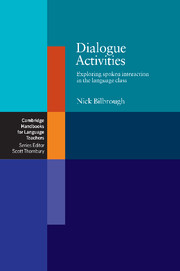Book contents
- Frontmatter
- Contents
- Thanks and acknowledgements
- Introduction
- 1 Understanding
- 2 Analysing
- 3 Reproducing and reconstructing
- 4 Memorising
- 5 Rehearsing and performing
- 6 Co-constructing
- 7 Creating and personalising
- 8 Communicating
- 9 Dialogue as learning
- Dialogue Bank A From the film Mulholland Drive
- Dialogue Bank B Authentic snippets
- Dialogue Bank C Snippets from fairy tales
- Dialogue Bank D Lame jokes
- Dialogue Bank E Situational dialogues
- Dialogue Bank F ‘Dating Agency’ from the comedy series Little Britain
- Further reading and resources
- Index
- Frontmatter
- Contents
- Thanks and acknowledgements
- Introduction
- 1 Understanding
- 2 Analysing
- 3 Reproducing and reconstructing
- 4 Memorising
- 5 Rehearsing and performing
- 6 Co-constructing
- 7 Creating and personalising
- 8 Communicating
- 9 Dialogue as learning
- Dialogue Bank A From the film Mulholland Drive
- Dialogue Bank B Authentic snippets
- Dialogue Bank C Snippets from fairy tales
- Dialogue Bank D Lame jokes
- Dialogue Bank E Situational dialogues
- Dialogue Bank F ‘Dating Agency’ from the comedy series Little Britain
- Further reading and resources
- Index
Summary
An ability to understand the dialogues which students hear and read in the world around them must be a starting point for any dialogue work. The activities in this first chapter all use a written, spoken or written and spoken dialogue as a source of input for the students to engage with.
A traditional approach to developing listening skills in the classroom is to set students a range of tasks to complete whilst listening to the recording of a dialogue. Understanding dialogues: a basic procedure (1.1) and Board grab(1.2) illustrate some of these techniques.
Many learners, however, are also keen to have access to the written form of the dialogue at some point, because it allows processing of the text in a different way. Reading versus listening (1.3) aims to raise students' awareness about the advantages and disadvantages of being able to see the tapescript which often accompanies spoken coursebook dialogues.
Dialogue interpretation worksheets (1.4), Jigsaw (1.5), and Designing exam questions (1.6) turn things on their head, and use the written form of the dialogue as the point of entry for the learners. The students first read the dialogue, then they listen to it. This requires a different kind of processing.
In What are they talking about? (1.7), Snippets (1.8) and Fairy tale tableaux (1.9) the learners are exposed to only the written format of quite short dialogues and encouraged to interpret the wider context in which the dialogue occurs.
- Type
- Chapter
- Information
- Dialogue ActivitiesExploring Spoken Interaction in the Language Class, pp. 18 - 38Publisher: Cambridge University PressPrint publication year: 2007



